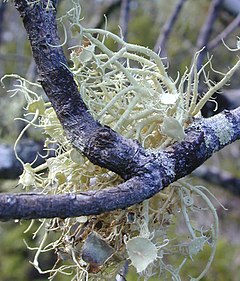Usnea
From Wikipedia, the free encyclopedia
 |
| Usnea australis |
| Scientific classification | |
|---|---|
| Kingdom: | Fungi |
| Division: | Ascomycota |
| Class: | Lecanoromycetes |
| Order: | Lecanorales |
| Family: | Parmeliaceae |
| Genus: | Usnea |
| Species | |
| See text. | |
Usnea is a genus of mostly pale grayish-green fruticose lichens that grow like leafless mini-shrubs or tassels anchored on bark or twigs. The genus is in the Parmeliaceae family. It grows all over the world.
Members of the genus are commonly called tree's dandruff, woman's long hair, or tree moss, old man's beard, or beard lichen. It resembles Evernia, which is also called tree moss.
Like other lichens it is a symbiosis of a fungus and an alga. The fungus belongs to the division Ascomycota, while the alga is a member of the division Chlorophyta.
Members of the genus are similar to those of the genus Alectoria. A test for the different is that the branches of Usnea are somewhat elastic, but the branches of Alectoeria snap cleanly off.
Morphology and reproduction
As a fruticose lichen, Usnea appears as a shrub-like growth on host trees. It reproduces via vegetative means through fragmentation, asexual means through soredia, or sexual means through ascogonium and spermatogonium. The growth rate of lichens in nature is slow, but the growth rate has been sped up in laboratory conditions where Usnea is being cultured. Usnea looks very similar to Spanish moss, so much so that the latter plant's Latin name is derived from it (Tillandsia usneoides, the 'Usnea-like Tillandsia').Taxonomy
Many species have been described. A three-volume series by Józef Motyka published in 1936 and 1947 distinguished 451 species. Many of these are now regarded as morphological varieties and adaptations to local circumstances. The taxonomic categorization of many members of this genus remains uncertain. The number of recognized species in Finland is decreasing for this reason, from 34 in 1951 to 25 in 1963 and only 12 in 2000. It is now noted as including more than 600 species and being one of the largest genera within the Parmeliaceae. The species Usnea longissima was renamed Dolichousnea longissima in 2004.Ecology
Like other lichens, Usnea often grows on sick or dying trees due to the pre-existing loss of canopy leaves, allowing for greater photosynthesis by the lichen's algae; this leads some gardeners to mistakenly blame the lichen for the tree's leaf loss and illness.Usnea is very sensitive to air pollution, especially sulfur dioxide. Under bad conditions they may grow no larger than a few millimetres, if they survive at all. Where the air is unpolluted, they can grow to 10–20 cm long.
Uses
Medical claims
Prescientific medical systems included use of Usnea in the belief it had healing effects for at least 1600 years.Usnea was one ingredient in a product called Lipokinetix, promoted to induce weight loss via increase in metabolic rate. Lipokinetix has been the topic of an FDA warning in the USA, due to potential hepatotoxicity, although it is unclear yet if any toxicity would be attributable to the Usnea. Lipokinetix also contained PPA, caffeine, yohimbine and diiodothyronine.
There is reason to believe that Usnea, in high concentrations, could possess some toxicity. The National Toxicology Program is currently evaluating the issue.
Tidak ada komentar:
Posting Komentar